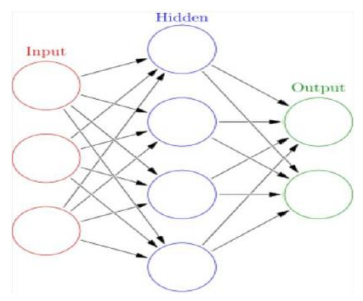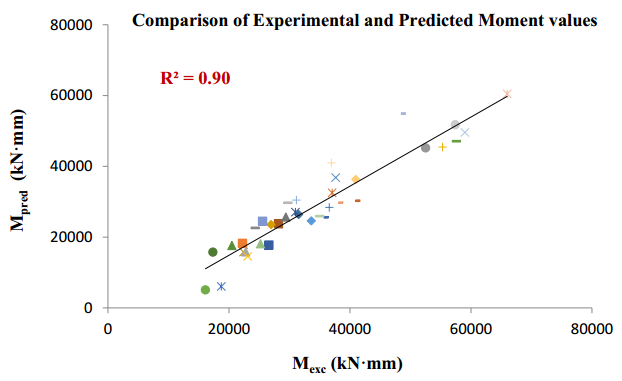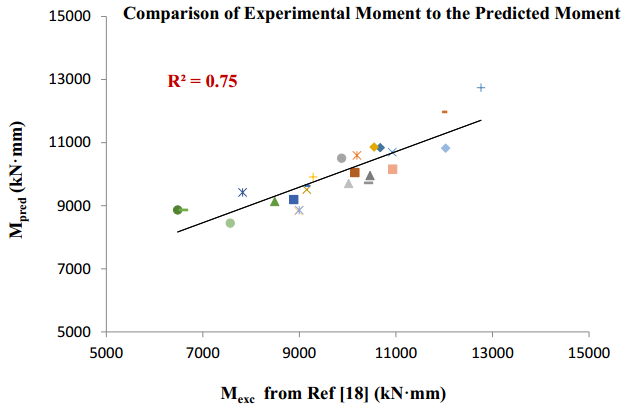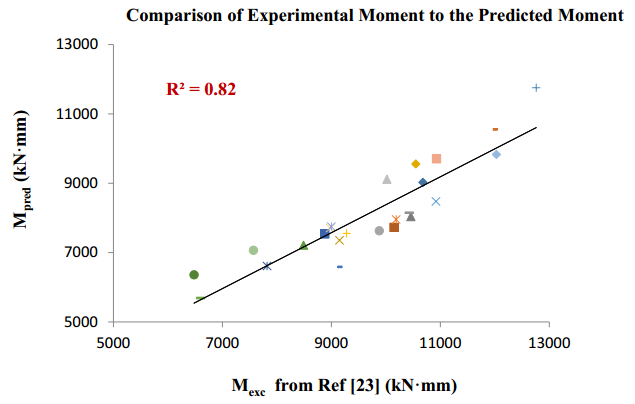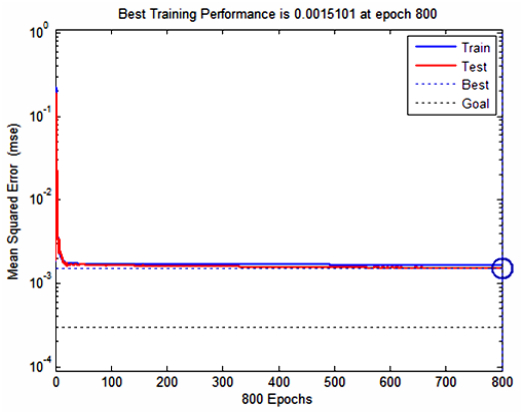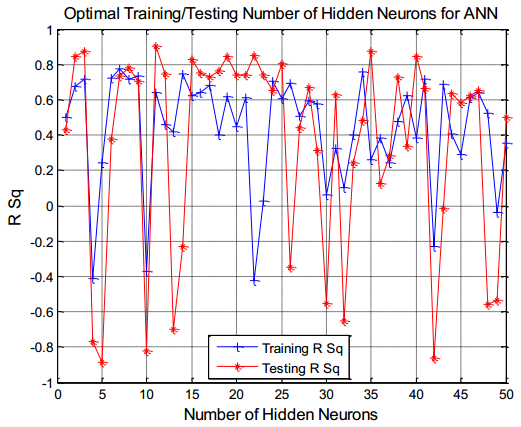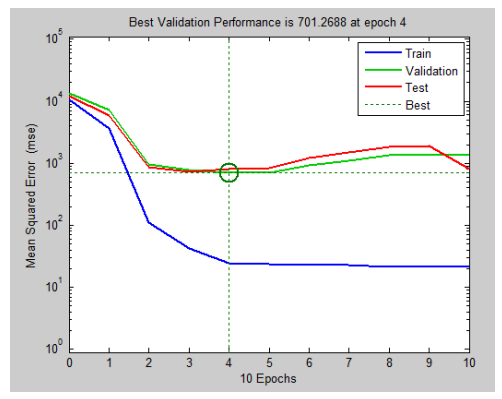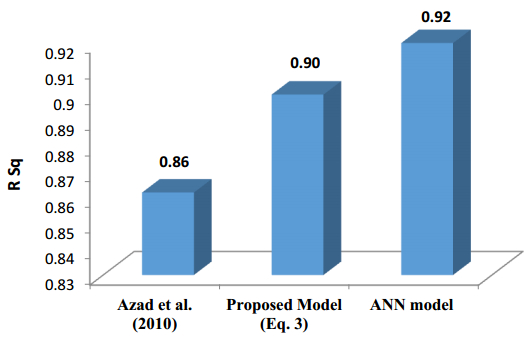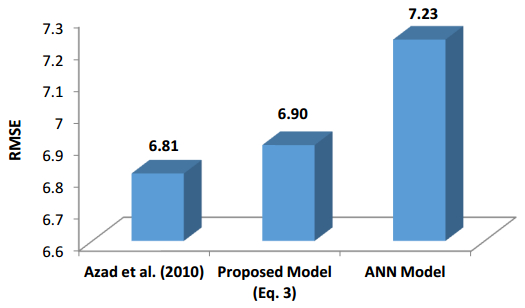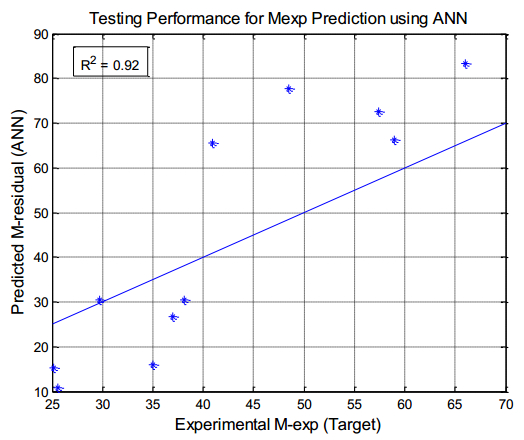There have been many extensive studies on the prediction of the residual strength of corroded reinforced concrete beams from experimental and theoretical perspectives in the past. This article corroborated the findings of Azad et al. (2010) pertaining to the residual strength and safety of the corroded beams and an insight to develop an improved regression model to obtain more practical outcomes. The proposed model has further been verified with the past research data to obtain a validation error to its minimum count. The study is also followed by the use of soft computing technique like Artificial Neural Networks (ANN) to establish a method with substantial improvement in the prediction results of residual strength. One ANN model is proposed to predict the residual capacity of corroded reinforced concrete beams using the same data from Azad et al. (2010). The effects of fixed data stratification on the performance of the models have been studied. The results of the ANN model were found to be in good agreement with experimental values. When compared with the results of Azad et al. (2010), the ANN model with fixed data stratification gave a better prediction for residual strength with reference to correlation coefficient and error reduction. Hence, the reliability of ANN model is assured with the prediction work followed in this study.
1.
Introduction
In the last few decades, more and more scholars have studied fractional-order neural networks (FONNs) due to their powerful functions [1,2]. FONNs have been accurately applied to image processing, biological systems and so on [3,4,5,6] because of their powerful computing power and information storage capabilities. In the past, scholars have studied many types of neural network (NN) models. For example, bidirectional associative memory neural networks (BAMNNs) [7], recurrent NNs [8], Hopfield NNs [9], Cohen-Grossberg NNs [10], and fuzzy neural networks (FNNs) [11]. With the development of fuzzy mathematics, Yang et al. proposed fuzzy logic (fuzzy OR and fuzzy AND) into cellular NNs and established FNNs. Moreover, when dealing with some practical problems, it is inevitable to encounter approximation, uncertainty, and fuzziness. Fuzzy logic is considered to be a promising tool to deal with these phenomena. Therefore, the dynamical behaviors of FNNs have attracted extensive research and obtained abundant achievements [12,13,14,15].
The CVNNs are extended from real-valued NNs (RVNNs). In CVNNs, the relevant variables in CVNNs belong to the complex field. In addition, CVNNs can also address issues that can not be addressed by RVNNs, such as machine learning [16] and filtering [17]. In recent years, the dynamic behavior of complex valued neural networks has been a hot topic of research for scholars. In [16], Nitta derived some results of an analysis on the decision boundaries of CVNNs. In [17], the author studied an extension of the RBFN for complex-valued signals. In [18], Li et al. obtained some synchronization results of CVNNs with time delay. Overall, CVNNs outperform real-valued neural networks in terms of performance, as they can directly process two-dimensional data.
Time delays are inescapable in neural systems due to the limited propagation velocity between different neurons. Time delay has been extensively studied by previous researchers, such as general time delay [19], leakage delays [20], proportional delays [21], discrete delays [22], time-varying delays [23], and distributed delays [24]. In addition, the size and length of axonal connections between neurons in NNs can cause time delays, so scholars have introduced distributed delays in NNs. For example, Si et al. [25] considered a fractional NN with distributed and discrete time delays. It not only embodies the heredity and memory characteristics of neural networks but also reflects the unevenness of delay in the process of information transmission due to the addition of distributed time delays. Therefore, more and more scholars have added distributed delays to the NNs and have made some new discoveries [26,27]. On the other hand, due to the presence of external perturbations in the model, the actual values of the parameters in the NNs cannot be acquired, which may lead to parameter uncertainties. Parameter uncertainty has also affected the performance of NNs. Consequently, scholars are also closely studying the NNs model of parameter uncertainty [28,29].
The synchronization control of dynamical systems has always been the main aspect of dynamical behavior analysis, and the synchronization of NNs has become a research hotspot. In recent years, scholars have studied some important synchronization behaviors, such as complete synchronization (CS) [30], global asymptotic synchronization [31], quasi synchronization [32], finite time synchronization [33], projective synchronization (PS) [34], and Mittag-Leffler synchronization (MLS) [35]. In various synchronizations, PS is one of the most interesting, being characterized by the fact that the drive-response systems can reach synchronization according to a scaling factor. Meanwhile, the CS can be regarded as a PS with a scale factor of 1. Although PS has its advantages, MLS also has its unique features. Unlike CS, MLS can achieve synchronization at a faster speed. As a result, some scholars have combined the projective synchronization and ML synchronization to study MLPS [36,37]. However, there are few papers on MLPS of FOFNNs. Based on the above discussion, the innovative points of this article are as follows:
∙ According to the FNNs model, parameter uncertainty and distributed delays are added, and the influence of time-varying delay, distributed delay, and uncertainty on the global MLPS of FOFCVNNs is further considered in this paper.
∙ The algebraic criterion for MLPS was obtained by applying the complex valued direct method. Direct methods and algebraic inequalities greatly reduce computational complexity.
∙ The design of nonlinear hybrid controllers and adaptive hybrid controllers greatly reduces control costs.
Notations: In this article, C refers to the set of complex numbers, where O=OR+iOI∈C and OR,OI∈R, i represents imaginary units, Cn can describe a set of n-dimensional complex vectors, ¯Oψ refers to the conjugate of Oψ. |Oψ|=√Oψ¯Oψ indicating the module of Oψ. For O=(O1,O2,…,On)T∈Cn,||O||=(n∑ψ=1|Oψ|2)12 denotes the norm of O.
2.
Preliminaries
In this section, we provide the definitions, lemmas, assumptions, and model details required for this article.
Definition 2.1. [38] The Caputo fractional derivative with 0<Υ<1 of function O(t) is defined as
Definition 2.2. [38] The one-parameter ML function is described as
Lemma 2.1. [39] Make Qψ,Oψ∈C(w,ψ=1,2,…,n,), then the fuzzy operators in the system satisfy
Lemma 2.2. [40] If the function ϑ(t)∈C is differentiable, then it has
Lemma 2.3. [41] Let ˆξ1,ˆξ2∈C, then the following condition:
holds for any positive constant χ>0.
Lemma 2.4. [42] If the function ς(t) is nondecreasing and differentiable on [t0,∞], the following inequality holds:
where constant ȷ is arbitrary.
Lemma 2.5. [43] Suppose that function ℏ(t) is continuous and satisfies
where 0<α<1, γ∈R, the below inequality can be obtained:
Next, a FOFCVNNS model with distributed and time-varying delays with uncertain coefficients is considered as the driving system:
where 0<α<1; O(t)=((O1(t),...,On(t))⊤; Ow(t),w=1,2,...,n is the state vector; aw∈R denotes the self-feedback coefficient; mwψ∈C stands for a feedback template element; △mwψ∈C refers to uncertain parameters; μwψ∈C and υwψ∈C are the elements of fuzzy feedback MIN and MAX templates; ⋁ and ⋀ indicate that the fuzzy OR and fuzzy AND operations; τ(t) indicates delay; Iw(t) denotes external input; and fψ(⋅) is the neuron activation function.
Correspondingly, we define the response system as follows:
where Uw(t)∈C stands for controller. In the following formula, Ct0Dαt is abbreviated as Dα.
Defining the error as kw(t)=Qw(t)−SOw(t), where S is the projective coefficient. Therefore, we have
where fψ~kψ(t)=fψ(Qψ(t))−fψ(SOψ(t)).
Assumption 2.1. ∀O,Q∈C and ∀Lϖ>0, fϖ(⋅) satisfy
Assumption 2.2. The nonnegative functions bwψ(t) and cwψ(t) are continuous, and satisfy
Assumption 2.3. The parameter perturbations △mwψ(t) bounded, then it has
where Mwψ is all positive constants.
Assumption 2.4. Based on the assumption for fuzzy OR and AND operations, the following inequalities hold:
where δψ and ηψ are positive numbers.
Definition 2.3. The constant vector O∗=(O∗1,…,O∗n)T∈Cn and satisfy
whereupon, O∗ is called the equilibrium point of (2.1).
Definition 2.4. System (2.1) achieves ML stability if and only if O∗=(O∗1,…,O∗n)T∈Cn is the equilibrium point, and satisfies the following condition:
where 0<α<1,ρ, η>0,Ξ(0)=0.
Definition 2.5. If FOFCVNNS (2.1) and (2.2) meet the following equation:
so we can say it has achieved projective synchronization, where S∈R is projective coefficient.
3.
Main results
In this part, we mainly investigate three theorems. According to the Banach contraction mapping principle, we can deduce the result of Theorem 3.1. Next, we construct a linear hybrid controller and an adaptive hybrid controller, and establish two MLPS criteria.
Theorem 3.1. B is a Banach space. Let ||O||1=n∑ψ=1|Oψ|. Under Assumptions 2.1–2.4, if the following equality holds:
then FOFCVNNS (2.1) has a unique equilibrium point with O∗=(O∗1,…,O∗n)T∈Cn.
Proof. Let O=(~O1,~O2,…,~On)⊤=(a1O1,a2O2,…,anOn)⊤∈Rn, and construct a mapping φ:B→B, φ(x)=(φ1(O),φ2(O),…,φn(O))⊤ and
For two different points α=(α1,…,αn)⊤,β=(β1,…,βn)⊤, it has
According to Assumption 2.1, we get
Next, we have
From Assumption 2.3, then it has
Finally, we obtain
where φ is obviously a contraction mapping. From Eq (3.2), there must exist a unique fixed point ~O∗∈Cn, such that φ(~O∗)=~O∗.
Let O∗ψ=~O∗ψaψ, we have
Consequently, Theorem 3.1 holds.
Under the error system (2.3), we design a suitable hybrid controller
By substituting (3.10)–(3.12) into (2.3), it yields
Theorem 3.2. Based on the controller (3.10) and Assumptions 2.1–2.4, systems (2.1) and (2.2) can achieve MLPS if the following formula holds:
Proof. Picking the Lyapunov function as
By application about derivative v1(t), we derive
Following Lemma 2.2, it has
Substituting Eq (3.13) to (3.17), we can get
Combining Lemma 2.3, one gets
Based on (3.19), we derive
According to Assumptions 2.1 and 2.3, Lemma 2.3, we can get
Based on Lemma 2.3, one has
Combining Assumption 2.4 and Lemma 2.1, one obtains
Substituting (3.23) into (3.22), it has
Thus,
Substituting (3.20)–(3.25) into (3.18), we get
Applying the fractional Razumikhin theorem, the inequality (3.26) is as follows:
Apparently, from Lemma 2.5, it has
and
Moreover,
From Definition 2.4, system (2.1) is Mittag-Leffler stable. From Definition 2.5 and limt→∞||k(t)||=0, the derive-response systems (2.1) and (2.2) can reach MLPS. Therefore, Theorem 3.2 holds.
Unlike controller (3.11), we redesign an adaptive hybrid controller as follows:
Taking (3.12) and (3.32) into (3.31), then
Theorem 3.3. Assume that Assumptions 2.1–2.4 hold and under the controller (3.31), if the positive constants Υ1, Υ2, Ω1, and Ω2 such that
we can get systems (2.1) and (2.2) to achieve MLPS.
Proof. Taking into account the Lyapunov function
By utilizing Lemmas 2.2 and 2.4, then it has
Substituting (3.32) into (3.36), one has
Substituting (3.33) into R1 yields
According to the inequality (3.20), it has
Substituting (3.39) and (3.21)–(3.25) into (3.38), we have
Substituting (3.37) and (3.40) into (3.36), we finally get
By applying fractional-order Razumikhin theorem, the following formula holds:
Let Ξ=min(Υ1−Υ2Ω2,2p), then
According to Lemma 2.5, one has
From Eq (3.35), we can deduce
and
Therefore, it has
and
Obviously, from Definition 2.4, system (2.1) is Mittag-Leffler stable. From Definition 2.5 and limt→∞||k(t)||=0, systems (2.1) and (2.2) can reach MLPS.
Remark 3.1. Unlike adaptive controllers [12], linear feedback control [16], and hybrid controller [34], this article constructs two different types of controllers: nonlinear hybrid controller and adaptive hybrid controller. The hybrid controller has high flexibility, strong scalability, strong anti-interference ability, and good real-time performance. At the same time, hybrid adaptive controllers not only have the good performance of hybrid controllers but also the advantages of adaptive controllers. Adaptive controllers reduce control costs, greatly shorten synchronization time, and can achieve stable tracking accuracy. Different from the research on MLPS in literature [33,34,35], this paper adopts a complex valued fuzzy neural network model, while fully considering the impact of delay and uncertainty on actual situations. At the same time, it is worth mentioning that in terms of methods, we use complex-value direct method, appropriate inequality techniques, and hybrid control techniques, which greatly reduce the complexity of calculations.
4.
Examples
In this section, we use the MATLAB toolbox to simulate theorem results.
Example 4.1. Study the following two-dimensional complex-valued FOFCVNNS:
where Ow(t)=ORw(t)+iOIw(t)∈C, ORw(t),OIw(t)∈R, τ1(t)=τ2(t)=|tan(t)| I1(t)=I2(t)=0, fp(Op(t))=tanh(ORp(t))+itanh(OIp(t)).
The response system is
where Qw(t)=QRw(t)+iQIw(t)∈C. The initial values of (4.1) and (4.2) are
The phase portraits of system (4.1) are shown in Figure 1. The nonlinear hybrid controller is designed as (3.10), and picking α=0.95, S=0.55, δ1=δ2=1.1, η1=η2=1.3, L1=L2=0.11, λ=0.5. By calculation, we get ϖ1=4.47>0, ϖ2=0.71. Taking Ω1=1.5, then ϖ1−ϖ2Ω1>0. This also confirms that the images drawn using the MATLAB toolbox conform to the theoretical results of Theorem 3.2. Figures 2 and 3 show the state trajectory of kw(t) and ||kw(t)|| without the controller (3.10). Figures 4 and 5 show state trajectories and error norms with the controller (3.10), respectively.
Example 4.2. Taking α=0.95, S=0.97, k1=k2=5.1, ς1=ς2=0.2, ς∗1=5, ς∗2=8, δ1=δ2=1.1, η1=η2=1.5, L1=L2=0.1. The remaining parameters follow the ones mentioned earlier. According to calculation, Υ1=12.49, Υ2=7.36. Let Ω2=1.1, then we have Ω1−Υ2Ω2>0. Figure 6 depicts the state trajectory diagram of kw(t) with adaptive controller (3.31). Figure 7 describes the error norm ||kw(t)|| with controller (3.31). According to Figure 8, it is easy to see that the control parameters ςw(t) are constant.
Example 4.3. Consider the following data:
Let the initial value be
Picking α=0.88, S=0.9, δ1=δ2=1.2, η1=η2=1.5, L1=L2=0.1, λ=0.5, Ω1=2. After calculation, ϖ1=6.62>0, ϖ2=2.28, and ϖ1−ϖ2Ω1>0. Similar to Example 4.1, Figures 9 and 10 show the state trajectory of kw(t) and ||kw(t)|| without the controller (3.10). Figures 11 and 12 show state trajectories and error norms with the controller (3.10), respectively.
Example 4.4. Taking α=0.88, S=0.9, k1=k2=2.2, ς1=ς2=0.2, ς∗1=4, ς∗2=9, δ1=δ2=1.1, η1=η2=1.5, L1=L2=0.1, Ω2=2. The other parameters are the same as Example 4.3, where Υ1=22.29, Υ2=10.67, and Ω1−Υ2Ω2>0. Thus, the conditions of Theorem 3.3 are satisfied. Figure 13 depicts the state trajectory diagram of kw(t) with adaptive controller (3.31). Figure 14 describes the error norm ||kw(t)|| with controller (3.31). Control parameters ςw(t) are described in Figure 15.
5.
Conclusions
In this paper, we studied MLPS issues of delayed FOFCVNNs. First, according to the principle of contraction and projection, a sufficient criterion for the existence and uniqueness of the equilibrium point of FOFCVNNs is obtained. Second, based on the basic theory of fractional calculus, inequality analysis techniques, Lyapunov function method, and fractional Razunikhin theorem, the MLPS criterion of FOFCVNNs is derived. Finally, we run four simulation experiments to verify the theoretical results. At present, we have fully considered the delay and parameter uncertainty of neural networks and used continuous control methods in the synchronization process. However, regarding fractional calculus, there is a remarkable difference between continuous-time systems and discrete-time systems [14]. Therefore, in future work, we can consider converting the continuous time system proposed in this paper into discrete time system and further research discrete-time MLPS. Alternatively, we can consider studying finite-time MLPS based on the MLPS presented in this paper.
Authors contributions
Yang Xu: Writing–original draft; Zhouping Yin: Supervision, Writing–review; Yuanzhi Wang: Software; Qi Liu: Writing–review; Anwarud Din: Methodology. All authors have read and approved the final version of the manuscript for publication.
Use of AI tools declaration
The authors declare they have not used Artificial Intelligence (AI) tools in the creation of this article.
Conflict of interest
The authors declare no conflicts of interest.
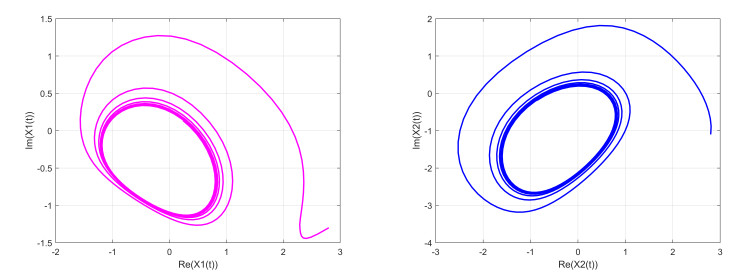









 DownLoad:
DownLoad:
















